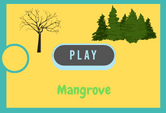Mangrove Game Quiz Online
This page features a Mangrove Game Quiz Online. It is an exercise for students studying science in 3rd, 4th, 5th, 6th to 8th grades. Students will learn about Mangrove in this online game. Play this game and learn about them. Remember to learn more by readding the article below.

How to Protect Mangroves
Mangroves are trees or shrub which grow in tidal, chiefly tropical, coastal swamps, having numerous tangled roots that grow above ground and form dense thickets. Protecting mangrove forests is important, but what can you do to help? You can choose to not consume shrimp from mangrove areas, donate money to local environmental organizations, and raise awareness about local projects. You can also do your part by reducing your carbon footprint. By living sustainably and recycling, you can help the mangroves remain pristine. And you can even help the mangroves by planting trees. Below, we've outlined some ways you can do your part to protect the mangroves.
Red mangrove
The resemblance between the red mangrove and the other species of tree lies in their similar reproductive processes. Red mangrove seedlings germinate and develop while attached to their parent trees. Then, when the seedlings fall to the water, they may take root alongside the parent tree or be carried by the tides to a suitable habitat. This type of germination makes them much more resistant to natural disasters and disease.
Red mangroves are unique among the plant kingdom. They thrive in salt water and have carved out an ecological niche for themselves. Their roots allow oxygen to reach the pores in their bark and also filter salt from the water. Additionally, their leaves, bark, and seeds are edible and are used in food production and natural dyes. Their bark, leaves, and seeds can be used to create various shades of red, olive, and brown.
Pneumatophores
Mangrove plants possess specialized roots called pneumatophores that help them extract oxygen from saltwater. These roots are long and white, originating from the trunk of the mangrove tree. Their small pores allow oxygen to diffuse into the root, and their large surface area increases the amount of oxygen that they can absorb. However, the process of pneumatophore development is still unknown.
Most terrestrial plants have taproots, but mangrove species rely on cable roots. The tangled roots provide stability and access to oxygen. Mangrove cable roots have cone or pencil-like lobes called pneumatophores, which act like snorkels in partially-flooded areas. These roots also have lenticels, which repel water. If you'd like to know more about mangrove roots, keep reading!
Shrimp farming in mangrove areas
The economic and environmental benefits of shrimp farming in mangrove areas are far outweighed by the negative impacts of the activity. According to Hamilton (2013), mangrove area was lost in eight countries from 1980 to 2005. Of this, 51.9% was converted to shrimp farming. Assuming that shrimp farming was the main culprit, the loss was substantial. According to Hamilton (2013), considerable conversion has occurred in China, Indonesia, and Bangladesh. It remains to be seen if these conversions will have any positive impact on the future of mangroves.
